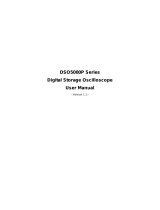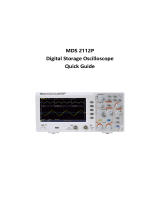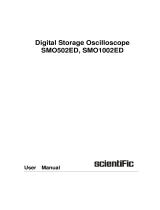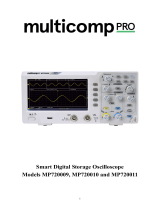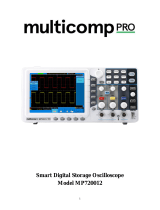Page is loading ...

xx
TDS1000B & TDS2000B Series
Digital Storage Oscilloscopes
Operator Training Kit Manual
*P07122 1901*
071-2199-01
1100111001010
11
0110011
11011
11
010100101101
001
1110110111
0101011
01010


TDS1000B and TDS2000B Series
Oscilloscopes
Operator Training Kit Manual
071-2199-01
www.tektronix.com

Copyright © Tektronix. All rights reserved. Licensed software products are
owned by Tektronix or its subsidiaries or suppliers, and are protected by
national copyright laws and international treaty provisions.
Tektroni x product s are covered by U.S. and foreign patents, issued and
pending. Information in this publicat ion supercedes that in all previously
published material. Specifications and price change privileges reserved.
TEKT RONIX and TEK are registered trademarks of Tektronix, Inc.
End users of this Tektronix product training document file are permitted to
print any portion of this file or copy the electronic file for personal use. Print
or electronic reproduction of this product tra ining document file for resale is
strictly prohibited.
Contacting Tektronix
Tektronix, Inc .
14200 SW Karl Braun Drive
P.O. Box 500
Beaverton, OR 97077
USA
For product information, sales, service, and technical support:
H In North America, call 1-800-833-9200.
H Worldwide, visit www.tektronix.com to find contacts in your area.

TDS1000B and TDS2000B Series Oscilloscopes -- Operator Training Kit
General Safety Summary
Review the following safety precautions to avoid injury and prevent
damage to this product or any products connected to it. To avoid
potential hazards, use this product only as specifie d.
While using this product, you may ne ed to access other parts of the
system. Read the General Safety Summary in other system manuals
for warnings and cautions relate d to operating the system.
To Avoid Fire or Personal Injury
Connect and Disconnect Properly. Do not connect or disconnect probes
or test leads while they a re connected to a voltage source.
Connect the ground lead of the probe to earth ground only.
Replace Batteries Properly. Replace batte ries only with the proper t ype
and rating specified.
Use Proper AC Adapter. Use only the AC adapter specified for this
product.
Use Proper Fuse. Use only the fuse type and rating specified for this
product.
Avoid Exposed Circuitry. Do not touch exposed connections and
components when power is present.
Do Not Operate With Suspected Failures. If you suspect there is damage
to this product, have it inspected by qualifie d service pe rsonnel.
Do Not Operate in Wet/Damp Conditions.
Do Not Operate in an Explosive Atmosphere.
Keep Product Surfaces C lean and Dry.

General Safety Summary
TDS1000B and TDS2000B Series Oscilloscopes -- Operator Training Kit
Safety Terms and Symbols
Terms in This Manual. These terms may appear in this manual:
WARNING. Warning statements identify condi tions or practices that
could result in injury or loss of life.
CAUTION. Caution statements identify condi tions or practices that
could result in damage to this product or other property.
Terms on the Product. These terms may appea r on the product:
DANGER indicates an injury hazard immediately accessible as you
read the marking.
WARNING indicates an injury hazard not immediately accessible as
you read the marking.
CAUTION indicates a hazard to property including the product.
Symbols on the Product. These symbols may appear on the product:
CAUTION
Refer to Manual
Standby

TDS1000B and TDS2000B Series Oscilloscopes -- Operator Training Kit
Environmental Considerations
This section provides informa tion about the environmental impact of
the product.
Product End-of-Life Handling
Observe the following guidelines when re cycling an instrument or
component:
Equipment Recycling. Production of this equipment required t he
extraction and use of natural resources. The equipment may contain
substances that could be harmful to the environment or human health
if improperly handled at the product’s end of life. In order to avoid
release of such substances into the environment and to reduce the use
of natural resources, we encourage you to recycle this product in an
appropriate system that will ensure that most of the materials are
reused or recycled appropriately.
The symbol shown to the left indicates that this
product complies with the European Union’s
requirements according to Directive 2002/96/EC
on waste electrical and electronic equipment
(WEEE). For information about recycling
options, check the Support/Service section of the
Tektronix Web site (www.tektronix.com).
Restriction of Hazardous Substances
This product has been classified as Monitoring a nd Control
equipment, and is outside the scope of the 2002/95/EC RoHS
Directive. This product is known to contain lead, cadmium , and
hexavalent chromium.

Environmental Considerations
TDS1000B and TDS2000B Series Oscilloscopes -- Operator Training Kit

TDS1000B and TDS2000B Series Oscilloscopes – Operator Training Kit i
Table of Contents
Introduction to Oscilloscopes and Probes ................................1-1
Getting to Know Oscilloscopes............................................. 1-2
Introduction to Oscilloscopes ........................................... 1-2
Types of Oscilloscopes .................................................... 1-5
Oscilloscope Terminology ..............................................1-14
Getting to Know Probes ..................................................... 1-23
Introduction to Probes ....................................................1-23
Types of Voltage Probes................................................1-24
How Probes Affect Measurements ................................1-27
Summary................................................................................. 1-31
Getting Started with the TDS1000B and TDS2000B
Series Oscilloscopes ................................................................ 2-1
Introduction to TDS1000B and TDS2000B Series
Oscilloscopes .......................................................................2-3
Features of the TDS1000B and TDS2000B Series
Oscilloscopes ...................................................................2-6
Safety Precautions .........................................................2-11
Preliminary Functional Check ........................................2-13
Introduction to the Training 1 Signal Board ................... 2-16
Probe Compensation .....................................................2-20
Primary Controls................................................................. 2-25
VERTICAL Controls ....................................................... 2-26
HORIZONTAL Controls.................................................. 2-39
TRIGGER Controls ........................................................2-45
Menu Function Controls .................................................2-59

ii TDS1000B and TDS2000B Series Oscilloscopes – Operator Training Kit
Enhanced Features ............................................................ 2-92
Help ................................................................................ 2-92
Autoset Feature............................................................2-103
DEFAULT SETUP Feature ..........................................2-112
SINGLE SEQ Feature .................................................. 2-112
PRINT / SAVE Feature ................................................2-113
Summary............................................................................... 2-114
Using VERTICAL Controls........................................................ 3-1
VERTICAL Controls.............................................................. 3-2
Setting Up VERTICAL Controls .......................................3-4
Switching the Input Coupling ...........................................3-6
VERTICAL Control MENU Buttons ....................................3-12
Modifying the Vertical Scale of a Displayed Waveform . 3-12
MATH MENU Controls .......................................................3-14
Adding Two Waveforms................................................. 3-14
Subtracting Two Waveforms..........................................3-17
Multiplying Two Waveforms ........................................... 3-20
Performing FFT Operations ........................................... 3-23
Summary................................................................................. 3-26
Using HORIZONTAL Controls .................................................. 4-1
HORIZONTAL Controls ........................................................ 4-2
Setting Up the HORIZONTAL Controls............................4-3
Setting the Delay Time for a Waveform...........................4-5
HORIZONTAL Control MENU Button................................... 4-8
Expanding the Waveform Display .................................... 4-8
Summary................................................................................. 4-13

TDS1000B and TDS2000B Series Oscilloscopes – Operator Training Kit iii
Using TRIGGER Controls......................................................... 5-1
Trigger Controls.................................................................... 5-2
TRIGGER MENU Controls ................................................... 5-4
Selecting a Trigger Type .................................................. 5-4
Selecting the Signal Coupling for a Trigger .....................5-8
Using an External Trigger ..............................................5-12
Triggering on a Specific Pulse Width ............................. 5-17
Capturing a Single-shot Signal ......................................5-22
Trigger Holdoff Controls .....................................................5-28
Assigning Trigger Holdoff to a Pseudo Random
Signal .............................................................................5-29
Assigning Trigger Holdoff to an AM Signal .................... 5-31
Summary................................................................................. 5-36
Using Menu Function Controls ................................................. 6-1
MENU Function Controls......................................................6-3
ACQUIRE Menu Function Controls...................................... 6-6
Using the Peak Detect Acquisition Mode.........................6-8
Using the Average Acquisition Mode .............................6-12
DISPLAY Menu Function Controls ..................................... 6-15
Selecting the Display Type ............................................ 6-16
Using Persistence ..........................................................6-19
Using the XY Display Mode ........................................... 6-22
CURSOR Menu Function Controls.....................................6-15
Measuring the Vertical Scale .........................................6-25
Measuring the Horizontal Scale .....................................6-28
Measuring Pulse Width .................................................. 6-30
Measuring Rise Time .....................................................6-33

iv TDS1000B and TDS2000B Series Oscilloscopes – Operator Training Kit
MEASURE Menu Function Controls .................................. 6-37
Taking Automatic Measurements ..................................6-37
SAVE/RECALL Menu Function Controls ...........................6-43
Saving and Recalling a Setup........................................6-43
Saving and Recalling a Waveform................................. 6-48
UTILITY Menu Function Controls.......................................6-51
Displaying the System Status ........................................6-51
REF MENU Function Controls ...........................................6-53
Turning On / Off a Reference Waveform .......................6-53
AUTORANGE Menu Function Controls ............................. 6-55
Automatic Adjustment of Oscilloscope Settings ............ 6-55
Summary................................................................................. 6-57
Appendix A: Training 1 Signal Board: Signal Definitions..........A-1
Appendix B: Glossary ...............................................................B-1

TDS1000B and TDS2000B Series Oscilloscopes – Operator Training Kit v
Symbols
Here is a list of symbols used in this Operator Training Kit.
These symbols will help you navigate faster and access
specific types of information quickly.
Icon Description
Cross Reference
Placed next to text that provides a
link to details of the topic being
referred.
Ease of Use
Placed next to text that explains
how a feature makes the
oscilloscope easier to use.
Note
Placed next to text that provides an
important piece of information
regarding a procedure or feature.
Objective
Placed next to text that lists the
objectives for the lessons.
Procedure Start
Placed next to text that introduces a
procedure.

vi TDS1000B and TDS2000B Series Oscilloscopes – Operator Training Kit

TDS1000B and TDS2000B Series Oscilloscopes – Operator Training Kit 1-1
1
Introduction to Oscilloscopes and
Probes
The environment around us contains various energy
sources, such as electronic appliances, which generate
signals. Oscilloscopes allow you to observe these signals to
analyze the performance of their energy sources. This
module introduces you to oscilloscopes and the methods to
measure electrical signals by using oscilloscopes and
associated probes.
At the end of this module, you will be able to:
• Identify the types of oscilloscopes.
• List the terms to describe the performance of
oscilloscopes.
• Identify the types of voltage probes.
• Describe the loading effects of probes on signals.

1
Introduction to Oscilloscopes and Probes
1-2 TDS1000B and TDS2000B Series Oscilloscopes – Operator Training Kit
Getting to Know Oscilloscopes
This section introduces you to oscilloscopes and describes
the different types of oscilloscopes and their functions. The
section includes the following topics:
• Introduction to Oscilloscopes
• Types of Oscilloscopes
• Oscilloscope Terminology
Introduction to Oscilloscopes
You use an oscilloscope to display electrical signals as
waveforms. A waveform is a graphical representation of a
wave.
An oscilloscope receives an electrical signal and converts it
into a waveform. The waveform shows the change in
voltage with time on the oscilloscope display screen.

1
Introduction to Oscilloscopes and Probes
TDS1000B and TDS2000B Series Oscilloscopes – Operator Training Kit 1-3
You can use an oscilloscope to determine the following:
• The frequency of an oscillating signal
• The malfunctioning component in an electrical circuit
• Whether the signal is direct current (DC) or alternating
current (AC)
• What part of the signal is noise
You can also use oscilloscopes to measure electrical
signals in response to physical stimuli, such as sound,
mechanical stress, pressure, light, or heat. For example, a
television technician can use an oscilloscope to measure
signals from a television circuit board while a medical
researcher can use an oscilloscope to measure brain
waves.

1
Introduction to Oscilloscopes and Probes
1-4 TDS1000B and TDS2000B Series Oscilloscopes – Operator Training Kit
An oscilloscope contains various controls that help you
analyze waveforms displayed on a graphical grid called a
graticule. The vertical or Y-axis of the graticule typically
represents voltage while the horizontal or X-axis typically
represents time.
Figure 1.1 shows how an oscilloscope displays voltage and
time.
Figure 1.1: Oscilloscope display

1
Introduction to Oscilloscopes and Probes
TDS1000B and TDS2000B Series Oscilloscopes – Operator Training Kit 1-5
Types of Oscilloscopes
Electronic equipment can be categorized into two types,
analog and digital. Analog equipment use variable voltages
while digital equipment use binary numbers that represent
voltage samples.
Similarly, oscilloscopes are categorized
into analog and digital.
Figure 1.2 shows an analog and a digital oscilloscope.
Figure 1.2: Analog and digital oscilloscopes

1
Introduction to Oscilloscopes and Probes
1-6 TDS1000B and TDS2000B Series Oscilloscopes – Operator Training Kit
Analog Oscilloscopes
Let us look at how analog oscilloscopes work. Figure 1.3
shows a block diagram of an analog oscilloscope.
Figure 1.3: Block diagram of an analog oscilloscope
When you connect an analog oscilloscope to a circuit, the
voltage signal from the circuit travels to the vertical
deflection plates of the oscilloscope screen, which is a
phosphor-coated cathode-ray tube (CRT). As a result, when
an electron beam strikes the phosphor coating of the CRT, a
glowing dot appears. When you apply voltage to the
deflection plates, the glowing dot moves.
/


